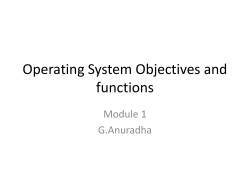
Chapter 13: I/O Systems
Chapter 13: I/O Systems • • • • I/O Hardware Application I/O Interface Kernel I/O Subsystem Transforming I/O Requests to Hardware Operations I/O Hardware • Incredible variety of I/O devices • Common concepts – Port – Bus (daisy chain or shared direct access) – Controller (host adapter) • I/O instructions control devices • Devices have addresses, used by – Direct I/O instructions (the controller has one or more registers for data and control signals). – Memory-mapped I/O (device control registers are mapped into the address space of the processor). A Typical PC Bus Structure Device I/O Port Locations on PCs (partial) Polling • Determines state of device – command-ready – busy – Error • Busy-wait cycle to wait for I/O from device Interrupts • CPU Interrupt-request line (a wired in CPU hardware) triggered by I/O device • When the CPU detects that a controller has asserted a signal on the interrupt-request line, the CPU performs a state save and jump to the interrupt-handler routine at a fixed address in memory. • Maskable to ignore or delay some interrupts when CPU is executing something critical • Interrupt vector to dispatch interrupt to correct handler – Based on priority – Some nonmaskable • Interrupt mechanism also used for exceptions Interrupt-Driven I/O Cycle Intel Pentium Processor Event-Vector Table Direct Memory Access • Used to avoid programmed I/O for large data movement • Requires DMA controller • Bypasses CPU to transfer data directly between I/O device and memory Six Step Process to Perform DMA Transfer Application I/O Interface • I/O system calls encapsulate device behaviors in generic classes • Device-driver layer hides differences among I/O controllers from kernel • Devices vary in many dimensions – Character-stream or block – Sequential or random-access – Sharable or dedicated – Speed of operation – read-write, read only, or write only A Kernel I/O Structure Characteristics of I/O Devices Block and Character Devices • Block devices include disk drives – Commands include read, write, seek – Raw I/O or file-system access – Memory-mapped file access possible • Character devices include keyboards, mice, serial ports – Commands include get(), put() – Libraries layered on top allow line editing Network Devices • Varying enough from block and character to have own interface • Unix and Windows NT/9x/2000 include socket interface – Separates network protocol from network operation – Includes select() functionality • Approaches vary widely (pipes, FIFOs, streams, queues, mailboxes) Clocks and Timers • Provide current time, elapsed time, timer • Programmable interval timer used for timings, periodic interrupts • ioctl() (on UNIX) covers odd aspects of I/O such as clocks and timers Blocking and Nonblocking I/O • Blocking - process suspended until I/O completed – Easy to use and understand – Insufficient for some needs • Nonblocking - I/O call returns as much as available – User interface, data copy (buffered I/O) – Implemented via multi-threading – Returns quickly with count of bytes read or Two I/O Methods Synchronous Asynchronous Device-status Table Sun Enterprise 6000 Device-Transfer Rates Kernel I/O Subsystem • Caching - fast memory holding copy of data – Always just a copy – Key to performance • Spooling - hold output for a device – If device can serve only one request at a time – i.e., Printing • Device reservation - provides exclusive access to a device Error Handling • OS can recover from disk read, device unavailable, transient write failures • Most return an error number or code when I/O request fails • System error logs hold problem reports I/O Protection • User process may accidentally or purposefully attempt to disrupt normal operation via illegal I/O instructions – All I/O instructions defined to be privileged – I/O must be performed via system calls • Memory-mapped and I/O port memory locations must be protected too Use of a System Call to Perform I/O Kernel Data Structures • Kernel keeps state info for I/O components, including open file tables, network connections, character device state • Many, many complex data structures to track buffers, memory allocation, “dirty” blocks • Some use object-oriented methods and message passing to implement I/O UNIX I/O Kernel Structure I/O Requests to Hardware Operations • Consider reading a file from disk for a process: – Determine device holding file – Translate name to device representation – Physically read data from disk into buffer – Make data available to requesting process – Return control to process Life Cycle of An I/O Request End of Chapter 13
© Copyright 2025





















